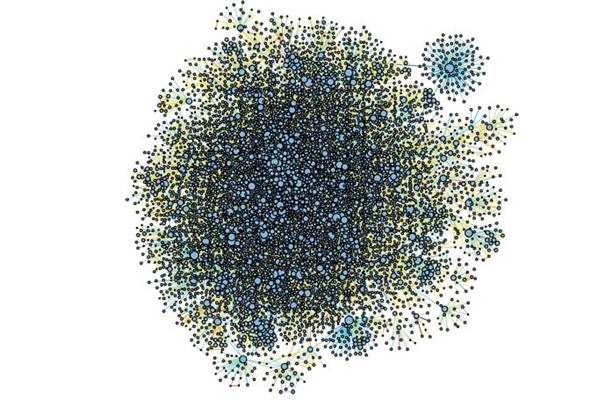A new study analyzed around 9,000 million calls throughout a nearly one year period and identified features of the communication process and attempted to quantify their impact in the diffusion of information.
The effect of the bursts is that it slows down the information diffusion since the large periods of inactivity in the communication between two persons make it less likely that information is passed from one to the other. The study in Physical Review E also highlights another important aspect of human communications: in group conversations, that is, although it is produced in bursts, these bursts happen at the same time among the members of the social group, which then accelerates information diffusion within these groups.

Static visualization of the social network of some of the persons speaking by phone (300,000 customers). Each circle is a customer and each line is a call between two customers. The network is very dense, a reflection of the small world of the social networks. Credit: UC3M
The main objective of the research was to try to understand the temporal pattern of communication among persons in a social network. "As opposed to the static vision of a social network (who I interact with), our study seeks to understand when and how these social relations are produced," said Prof. Esteban Moro, from the Grupo de Investigación Interdisciplinar de Sistemas Complejos at Universidad Carlos III de Madrid.
They wanted to see if relations in a social network can be quantified better, that is, determine if the communication rhythm between two persons allows us to know something about the "strength" or characteristics of the relation (family member, acquaintance, friend, colleague, etc..); and also to investigate the impact of these rhythms on the propagation of information in social networks, in processes such as viral marketing, product recommendations, etc.
This study was made possible by the framework agreement that the UC3M has with Telefónica I+D and a program of Becas de Formación de Doctores, in which the company provided access to totally anonymous databases of calls during a period of eleven months. In all, the researchers analyzed approximately 9,000 million calls between 20 million people, around 30 percent of the population. "This large volume of data and the extended time period guarantees the representiveness and universality in the results", pointed out another one of the study’s author, Giovanna Miritello, a PhD candidate in the Mathematics Department of UC3M.
Citation: Dynamical strength of social ties in information spreading,Giovanna Miritello, Esteban Moro y Lara Rubén, Physical Review E. Volume: 83. Issue: 4. ISSN: 1539-3755






Comments